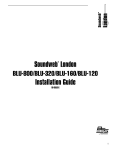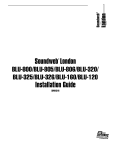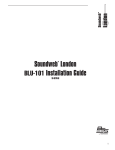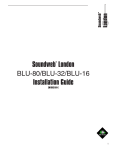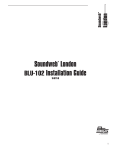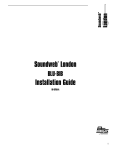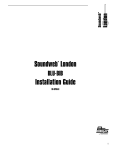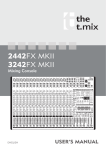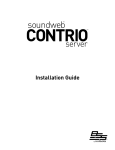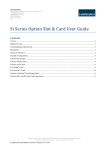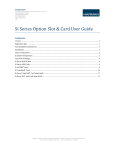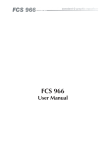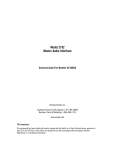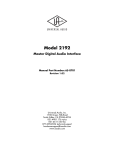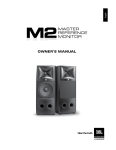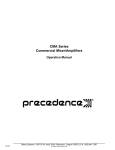Download BSS Audio Soundweb London BLU-160 Installation guide
Transcript
Soundweb London BLU-800/BLU-805/BLU-320/ BLU-325/BLU-160/BLU-120 Installation Guide TM 18-0553-D IMPORTANT SAFETY INSTRUCTIONS WARNING FOR YOUR PROTECTION READ THE FOLLOWING: KEEP THESE INSTRUCTIONS HEED ALL WARNINGS FOLLOW ALL INSTRUCTIONS The symbols shown above are internationally accepted symbols that warn of potential hazards with electrical products. The lightning flash with arrowpoint in an equilateral triangle means that there are dangerous voltages present within the unit. The exclamation point in an equilateral triangle indicates that it is necessary for the user to refer to the owner’s manual. These symbols warn that there are no user serviceable parts inside the unit. Do not open the unit. Do not attempt to service the unit yourself. Refer all servicing to qualified personnel. Opening the chassis for any reason will void the manufacturer’s warranty. Do not get the unit wet. If liquid is spilled on the unit, shut it off immediately and take it to a dealer for service. Disconnect the unit during storms to prevent damage. Safety Instructions Notice For Customers If Your Unit Is Equipped With A Power Cord. WARNING: THIS APPLIANCE SHALL BE CONNECTED TO A MAINS SOCKET OUTLET WITH A PROTECTIVE EARTHING CONNECTION. The cores in the mains lead are coloured in accordance with the following code: GREEN and YELLOW - Earth BLUE - Neutral BROWN - Live As colours of the cores in the mains lead of this appliance may not correspond with the coloured markings identifying the terminals in your plug, proceed as follows: • The core which is coloured green and yellow must be connected to the terminal in the plug marked with the letter E, or with the earth symbol, or coloured green, or green and yellow. • The core which is coloured blue must be connected to the terminal marked N or coloured black. • The core which is coloured brown must be connected to the terminal marked L or coloured red. This equipment may require the use of a different line cord, attachment plug, or both, depending on the available power source at installation. If the attachment plug needs to be changed, refer servicing to qualified service personnel who should refer to the table below. The green/ yellow wire shall be connected directly to the units chassis. CONDUCTOR WIRE COLOR Normal Alt L LIVE BROWN BLACK N NEUTRAL BLUE WHITE E EARTH GND GREEN/YEL GREEN WARNING: If the ground is defeated, certain fault conditions in the unit or in the system to which it is connected can result in full line voltage between chassis and earth ground. Severe injury or death can then result if the chassis and earth ground are touched simultaneously. 2 The apparatus shall not be exposed to dripping or splashing liquid and no object filled with liquid, such as vases, shall be placed on the apparatus CLEAN ONLY WITH A DRY CLOTH. DO NOT BLOCK ANY OF THE VENTILATION OPENINGS. INSTALL IN ACCORDANCE WITH THE MANUFACTURER’S INSTRUCTIONS. DO NOT INSTALL NEAR ANY HEAT SOURCES SUCH AS RADIATORS, HEAT REGISTERS, STOVES, OR OTHER APPARATUS (INCLUDING AMPLIFIERS) THAT PRODUCE HEAT. ONLY USE ATTACHMENTS/ACCESSORIES SPECIFIED BY THE MANUFACTURER. UNPLUG THIS APPARATUS DURING LIGHTNING STORMS OR WHEN UNUSED FOR LONG PERIODS OF TIME. Do not defeat the safety purpose of the polarized or grounding-type plug. A polarized plug has two blades with one wider than the other. A grounding type plug has two blades and a third grounding prong. The wide blade or third prong are provided for your safety. If the provided plug does not fit your outlet, consult an electrician for replacement of the obsolete outlet. Protect the power cord from being walked on or pinched particularly at plugs, convenience receptacles, and the point where they exit from the apparatus. Use only with the cart stand, tripod bracket, or table specified by the manufacture, or sold with the apparatus. When a cart is used, use caution when moving the cart/apparatus combination to avoid injury from tip-over. Refer all servicing to to qualified service personnel. Servicing is required when the apparatus has been damaged in any way, such as power-supply cord or plug is damaged, liquid has been spilled or objects have fallen into the apparatus, the apparatus has been exposed to rain or moisture, does not operate normally, or has been dropped. POWER ON/OFF SWITCH: For products provided with a power switch, the power switch DOES NOT break the connection from the mains. MAINS DISCONNECT: The plug shall remain readily operable. For rackmount or installation where plug is not accessible, an all-pole mains switch with a contact separation of at least 3 mm in each pole shall be incorporated into the electrical installation of the rack or building. FOR UNITS EQUIPPED WITH EXTERNALLY ACCESSIBLE FUSE RECEPTACLE: Replace fuse with same type and rating only. MULTIPLE-INPUT VOLTAGE: This equipment may require the use of a different line cord, attachment plug, or both, depending on the available power source at installation. Connect this equipment only to the power source indicated on the equipment rear panel. To reduce the risk of fire or electric shock, refer servicing to qualified service personnel or equivalent. If connected to 240V supply, a suitable CSA/UL certified power cord shall be used for this supply. IMPORTANT SAFETY INSTRUCTIONS DECLARATION OF CONFORMITY Manufacturer’s Name: BSS Audio Manufacturer’s Address:8760 S. Sandy Parkway Sandy, Utah 84070, USA Manufacturer’s Name: BSS Audio Manufacturer’s Address:8760 S. Sandy Parkway Sandy, Utah 84070, USA declares that the product: declares that the product: Product name(s):BLU 120, BLU160, BLU320, BLU800 Note: Product name may be suffixed by the EU. Product name(s): BLU 805 and BLU 325 Note: Product name may be suffixed by the EU. Product option: Various I/O Cards Product option: Various I/O Cards conforms to the following Product Specifications: Safety: EMC: IEC 60065 -01+Amd 1 EN 55022:2006 EN 55024:1998 FCC Part 15 Supplementary Information: conforms to the following Product Specifications: Safety: EMC: IEC 60065 -01+Amd 1 EN 55022:2006 EN 55024:1998 FCC Part 15 Supplementary Information: The product herewith complies with the requirements of the: Low Voltage Directive 2006/95/EC EMC Directive 2004/108/EC. RoHS Directive 2002/95/EC WEEE Directive 2002/96/EC The product herewith complies with the requirements of the: Low Voltage Directive 2006/95/EC EMC Directive 2004/108/EC. RoHS Directive 2002/95/EC WEEE Directive 2002/96/EC With regard to Directive 2005/32/EC and EC Regulation 1275/2008 of 17 December 2008, this product is designed, produced, and classified as Professional Audio Equipment and thus is exempt from this Directive. With regard to Directive 2005/32/EC and EC Regulation 1275/2008 of 17 December 2008, this product is designed, produced, and classified as Professional Audio Equipment and thus is exempt from this Directive. Roger Johnsen Director, Engineering Signal Processing 8760 S. Sandy Parkway Sandy, Utah 84070, USA Date: June 15, 2012 Roger Johnsen Director, Engineering Signal Processing 8760 S. Sandy Parkway Sandy, Utah 84070, USA Date: April 22, 2010 European Contact: Your local BSS Audio Sales and Service Office or Harman Music Group 8760 South Sandy Parkway Sandy, Utah 84070, USA Ph: (801) 566-8800 Fax: (801) 568-7583 U.K. MAINS PLUG WARNING A molded mains plug that has been cut off from the cord is unsafe. Discard the mains plug at a suitable disposal facility. NEVER UNDER ANY CIRCUMSTANCES SHOULD YOU INSERT A DAMAGED OR CUT MAINS PLUG INTO A 13 AMP POWER SOCKET. Do not use the mains plug without the fuse cover in place. Replacement fuse covers can be obtained from your local retailer. Replacement fuses are 13 amps and MUST be ASTA approved to BS1362. European Contact: Your local BSS Audio Sales and Service Office or Harman Signal Processing 8760 South Sandy Parkway Sandy, Utah 84070 USA Ph: (801) 566-8800 Fax: (801) 568-7583 ELECTROMAGNETIC COMPATIBILITY This device complies with part 15 of the FCC Rules and the Product Specifications noted on the Declaration of Conformity. Operation is subject to the following two conditions: • this device may not cause harmful interference, and • this device must accept any interference received, including interference that may cause undesired operation. Operation of this unit within significant electromagnetic fields should be avoided. • use only shielded interconnecting cables. If you want to dispose this product, do not mix it with general household waste. There is a separate collection system for used electronic products in accordance with legislation that requires proper treatment, recovery and recycling. Private households in the 25 member states of the EU, in Switzerland and Norway may return their used electronic products free of charge to designated collection facilities or to a retailer (if you purchase a similar new one). For Countries not mentioned above, please contact your local authorities for a correct method of disposal. By doing so you will ensure that your disposed product undergoes the necessary treatment, recovery and recycling and thus prevent potential negative effects on the environment and human health. 3 Regulatory Information An example of this equipment has been tested and found to comply with the following European and international Standards for Electromagnetic Compatibility and Electrical Safety: Radiated Emissions (EU): EN55022:2006 Immunity (EU): EN55024:1998 Electrical Safety (EU): IEC60065-01 + AMD1 Electrical safety (USA): UL60065-06 Important User Information Do not remove covers. No user serviceable parts inside, refer servicing to qualified service personnel. For continued compliance with international EMC regulations, it is important that all cables be screened, and connected as follows: Audio cable screens to their BLU-800 connector ground. Control cable screens to the ground screws adjacent to the connector. Network cables should be of type Cat 5, fitted with a clip-on ferrite sleeve (STEWART TYPE 28A2029-0A0) near the network socket end. This equipment must be earthed. It should not be necessary to remove any protective earth or signal cable shield connections to prevent ground loops. Any such disconnections are outside the recommended practice of BSS Audio, and will render the EMC or safety certificate void. Mechanical Installation CAUTION: TO REDUCE THE RISK RECHANGE DE MEME TYPE 100-240V ~ 50/60Hz, 55W THIS EQUIPMENT MUST BE EARTHED MANUFACTURED IN THE USA BY BSS AUDIO PRIMARY SECONDARY CobraNet 4 IN BLU link OF FIRE REPLACE ONLY WITH THE SAME TYPE AND RATING OF FUSE T1.6AH - 250V FUSE AVIS: UTILISER UN FUSIBLE DE IN OUT 3 2 1 S S S S S S S S RS232 ETHERNET WORD CLOCK 3 2 1 S S S S S S S S D OUT LOCATE 4 B A C If the unit is likely to undergo extreme vibration through extensive road trucking and touring, the unit must be supported at the rear and/or sides to lessen the stress on the front mounting flange. The necessary support can generally be bought ready-built as a rack tray, or the BLU-800/805/320/325/160/120 unit can be mounted between other units. Damage caused by insufficient support is not covered by the warranty. To prevent cosmetic damage to the front panel finish, use protective plastic cups under the rack mounting bolts. 4 Front Panel Input card monitoring Each channel has 3 LED indicators showing: •Clip Illuminated–Indicates clipping in the analogue domain for each channel of the fitted Input or Output card. The LED will illuminate at +18.5dB. •Signal Illuminated–The Signal LED will illuminate for each channel of a fitted Input or Output card when the signal reaches or exceeds the signal threshold of -20dB. •Sync/48V Illuminated–Illuminates to indicate +48V phantom power has been activated for the relevant channel of a fitted input card. Also indicates sync status for digital I/O card. Conductor [BLU-800/BLU-320/BLU160/BLU-120]/Master [BLU-805/BLU-325] The master clock device of a CobraNetTM system is referred to as the Conductor–the CM-1 modules in the system auto-negotiate which device will transmit the Conductor beat packet. The LED illuminates to indicate which device is acting as the Conductor. The master clock device of an AVB system is indicated with a Master LED on the front panel of the device that is providing the master clock function. Network Link The Network Link indicates the presence of Cat 5 Ethernet cables. If no cables are connected, the LED is unlit; the LED flashes if either a control or CobraNetTM/AVB cable is fitted and remains illuminated if both cables are connected. Data Activity The Data Activity LED will flash to indicate that the device is communicating with another control device, either on the network or via the serial or control ports. LCD Display Top line Indicates device name and run state. Bottom line indicates Time, IP Address, Subnet Mask, Model number with firmware version. Also, the device’s MAC Address can be viewed by powering the device on whilst pressing and holding the Locate switch. LOCATE Pressing the Locate switch on the front of the unit will illuminate the Locate switch on the rear and identify the device within London Architect. Similarly the switch will illuminate if the device is selected from within London Architect or from the Locate switch on the rear. Contrast (Hold) Pressing and holding the Locate switch will cycle the LCD through its contrast range. 5 Rear Panel CAUTION: TO REDUCE THE RISK RECHANGE DE MEME TYPE 100-240V ~ 50/60Hz, 55W THIS EQUIPMENT MUST BE EARTHED MANUFACTURED IN THE USA BY BSS AUDIO PRIMARY SECONDARY CobraNet 4 IN BLU link OF FIRE REPLACE ONLY WITH THE SAME TYPE AND RATING OF FUSE T1.6AH - 250V FUSE AVIS: UTILISER UN FUSIBLE DE IN OUT 3 2 1 S S S S S S S S RS232 ETHERNET WORD CLOCK BLU-800 shown above. BLU-320 layout is identical. BLU160 and BLU-120 have no CobraNetTM or WORD CLOCK BNC connectors, but are otherwise identical to the BLU800 and BLU-320. 3 2 1 S S S S S S S S D OUT LOCATE 4 B A C BLU-805 shown above. BLU-325 layout is identical. AC Mains AC Mains input to the universal switched-mode power supply, operates over a wide range of AC input voltages from 100V to 240V, 50/60Hz. CobraNetTM Connectors–Primary/Secondary [BLU-800/BLU-320] CobraNetTM is a licensed technology which allows CobraNetTM enabled Soundweb London devices to send and receive (simultaneously) up to 32 channels of audio to and from other CobraNetTM enabled devices. The CobraNetTM compatible devices within the SoundwebTM London system are fitted with a Peak Audio CobranetTM CM-1 module. The module itself offers a Primary and a Secondary CobranetTM port. Under normal operation, only the Primary port transmits and receives data to and from the network. Should the Primary port or connection fail, the CM-1 module automatically switches to receive from and transmit with the Secondary port. AVB [BLU-805/BLU-325] Ethernet AVB, or Audio/Video Bridging, is a common name for a set of IEEE standards that ensure the transmission of high quality streaming audio and video over a standard Ethernet connection. The BLU-805 and BLU-325 devices are fitted with an AVB module. The module allows Soundweb London devices to send and receive (simultaneously) up to 64 channels of audio to and from other AVB-enabled devices. The module offers a Primary and a Secondary AVB port. Under normal operation, only the Primary port transmits and receives data to and from the network. Should the Primary port or connection fail, the AVB module automatically switches to receive from and transmit with the Secondary port. NOTE: The Secondary port is not currently enabled. It will be enabled in a future release of HiQnet London Architect. The physical AVB connections must be made using Cat 5e cables and an AVB compatible network switch. See ‘Technical Specifications’ for compatible Ethernet Switches. Do not connect the AVB ports to any switch which does not support AVB! When connecting only two AVB devices together, a direct connection between devices can be made from the primary of one device to the primary of the other. BLU link The Soundweb London digital audio bus (also informally referred to as “BLU link”) is a point-to-point digital audio bus with 256 audio channels at 48K sample rate or 128 audio channels at 96K sample rate. The physical connection is made with Cat 5e cable from the OUT port of one device to the IN port of another device. The devices are connected in a daisy chain fashion continuing with the OUT port of one device connected to the IN port of the next device. Redundancy can be provided by completing the loop and connecting the OUT port from the last device to the IN port of the first device in the chain. DO NOT connect BLU link ports to a hub, network switch, or router. All devices connected in the BLU link ring/chain must be configured for the same audio sample rate. Locate Pressing the Locate switch on the rear of the unit will illuminate the Locate switch on the front and identify the device within London Architect. Similarly the switch will illuminate if the device is selected from within London Architect or from the Locate switch on the front panel. RS232 The serial port allows 3rd-party control equipment to control and monitor the Soundweb London. The Soundweb London can also send custom serial strings (in Decimal, Hexadecimal, or ASCII format) through the serial port. Therefore, the Soundweb London can control virtually any device which has a serial port and a publicly available protocol guide. Ethernet The main connection for the proprietary system control network. The Ethernet port allows BLU-8v2’s, BLU10’s, HiQnet London Architect, iOS devices, and 3rd-party control equipment to control and monitor the Soundweb London. The Ethernet port also allows the Soundweb London to send and receive design files to and from HiQnet London Architect. The Soundweb London can also send custom Ethernet messages (UDP or TCP; in Decimal, Hexadecimal, or ASCII format) through the Ethernet port. Therefore, the Soundweb London can control virtually any device which has an Ethernet port and a publicly available protocol guide. Word Clock [Buddy Link or 48k] [BLU-800/BLU-805/BLU-320/BLU-325] 6 On CobraNetTM equipped Soundweb London devices, these BNC connectors allow two similarly configured Soundweb London devices to be linked together and operate as a redundant pair. A 48kHz system clock is generated at the BNC OUT port when used in this fashion. If ‘Box B’ ceases to receive the 48kHz system clock from ‘Box A’, due to power failure of ‘Box A’, ‘Box B’ will take over and begin receiving and transmitting audio over the CobraNetTM network. These connectors can also facilitate integration with external clocks when using BLU link, allowing the Soundweb London devices to slave to a ‘house clock’, a common requirement in post-production, theatre, and broadcast applications. Synchronizing the Soundweb London internal DSP processing clock to the house clock avoids having to use Sample Rate Conversion on digital signals, resulting in superior audio. The supported sync frequencies are 48 kHz, 48 kHz pull-down (47.952 kHz), 96 kHz, and 96 kHz pull-down (95.904 kHz). Please refer to the London Architect help file for more information. The sample rate at which the Soundweb London device is running will be present on the WORD CLOCK OUT. NOTE: The BNC WORD CLOCK connectors serve no function when using AVB. Audio Cable Wiring All audio and control connections to the BLU-800/BLU-805/BLU-320/BLU-325/BLU-160/BLU-120 are via Klippon pluggable terminal block connectors (also known as BL, Phoenix or Combicon). 6-way female Klippon connectors (part number: 32-1226) are supplied for making these connections. Audio Input & Output Wiring Convention Soundweb products provide cable shielding ‘back from the destination’ to eliminate ground loop problems. This means that the shield (S) connection on an input is grounded, whereas the shield connection on an output is floating (although connected via an internal network to ground for EMC compliance). Balanced wiring–The convention for balanced wiring (2-core plus shield) is shown here: Balanced cable Cold Shield Hot Unbalanced wiring–The convention for unbalanced wiring to the inputs (1-core plus shield) is shown here: Unbalanced cable Shield Hot Link between pins (S) and (-) (optional for inputs) 7 I/O Card Positions A, B, C & D 4 IN N OUT 3 2 1 S S S S S S S S 3 2 1 S S S S S S S S D UT WORD CLOCK 4 B A C These connectors provide the balanced connections for the I/O card fitted in the four card slots in a Soundweb London device. The analogue connections are balanced, on Phoenix/Combicon connectors. A green LED next to the slot assignment letter A, B, C or D indicates that an Input card is fitted and an amber LED when an output card is fitted. Digital input cards are indicated with a blue LED and digital outputs cards with a red LED. AEC input cards are indicated with a white LED. Telephone Hybrid cards are indicated with a yellow LED. CONTROL INPUTS There are 12 control inputs, also known as ‘General Purpose Inputs’ or ‘GPI’. The control inputs are used to connect contact closures (for control of binary parameters, such as mutes), resistor ladders (for control of multistate parameters, such as source selectors) or potentiometers (for control of continuous parameters, such as volume faders). There are two common (ground) connections ‘C’ to the left of the 12 control inputs, and two software-assignable reference voltage outputs ‘R’ to the right. The control ports have two modes of operation: 2-wire and 3-wire. 2-Wire Mode In this mode, the 12 control inputs are internally ‘pulled up’ to +5V DC via a 4.7kOhm resistor. Therefore, no external voltage source is needed to create contact closure to ground for switches such as mute buttons or, resistance to ground (for other multi-state or continuous controls such as Parameter Presets or faders). unconnected 3600R 1800R 1200R See the Soundweb London help for a table of resistor values for use with Parameter Presets or source selectors. 47kOhm log potentiometer ladder switch 470R A 47kOhm-log potentiometer connected between a control input and common will allow parameters to be controlled linearly. 2-wire mode 3-Wire Mode This mode allows the use of linear pots or faders for continuous controls. A pot would be wired as a potential divider with the top of the track connected to the reference output R, the wiper to a control input and the bottom of the track to a common C. High performance pots with track resistance between 10kOhms and 100kOhms are recommended. 10K-100kOhm linear potentiometer 1k ladder 1k 8 1k 3-wire mode 1k 4k7 switch LOGIC OUTPUTS There are 6 logic outputs, also known as “General Purpose Outputs” or “GPO”. They are used to control LED’s or relays. The logic output can source 10mA at 5V DC, or sink 60mA up to 50V DC. A high sensitivity relay (such as a reed relay) can be driven by connecting multiple logic outputs in parallel. In the diagram to the right, this arrangement will develop 4V across a 500-Ohm coil, providing that all four outputs are activated simultaneously. When sourcing from the Logic Output, an LED connected between one output (Anode, A) and common (Cathode, K) will illuminate when the logic output is activated, without requiring any external current limiting resistor (the Soundweb London contains an internal 440 Ohm resistor). relay LED LED LD5 Port 1 Current source, 10mA max For higher current reed type relays you must use the Logic Output to sink current using an external power supply. VCC External supply Current sink, 60mA max Port 1 OPTO Output In addition to the six standard logic outputs, there is an isolated output, which fails safe (open circuit) if the unit becomes faulty. +supply voltage relay ground 9 Technical Specifications 10 FRONT PANEL LED INDICATORS Other: Per Input: Signal Present, CLIP, SYNC/48V, I/O card type [IN, OUT, DIG, AEC[BLU-800, 805, 320, 325, 160, 120]] LCD Display, Conductor active, Net Link active, Data Activity ANALOGUE INPUTS Mic/Line Inputs: Input impedance: Maximum input level: CMRR: Equiv. Input Noise [EIN]: Phantom power: A/D Latency [Rev. A]: A/D Latency [Rev. B]: Up to 16 electronically balanced on Phoenix/Combicon removable screw connectors Nominal gain 0dB, electronically switchable up to +48dB, in +6dB steps 3.5kOhm +20dBu with 0dB input gain, [+8dBu with 12dB gain] >40dB at 1kHz <-123dBu typ. with 150 Ohms source 48V nominal, selectable per input 41/Fs [0.85ms@48k, 0.43ms@96k] 12/Fs [0.25ms@48k, 0.13ms@96k] DIGITAL INPUTS Input impedance: Sample Rate: Sample Rate conversion: THD+N: Latency: Up to 16 AES/EBU or S/PDIF on Phoenix/Combicon removable screw connectors 110 ohm [AES/EBU], 75 ohm [S/PDIF] 48kHz or 96kHz 8kHz-96kHz <-140dB 3/Fso + [56.581/Fsi] + [55.658/Fso] AEC ANALOGUE INPUTS Mic/Line Inputs: Input impedance: Maximum input level: CMRR: Equiv. Input Noise [EIN]: Phantom power: Pre-AEC Input Latency: Post-AEC Input Latency: Tail Length: Convergence Rate: Up to 16 electronically balanced on Phoenix/Combicon removable screw connectors Nominal gain 0dB, electronically switchable up to +48dB, in +6dB steps 3.5kOhm +20dBu with 0dB input gain, +8dBu with 12dB gain >75dB at 1kHz <-128dBu typical with 150 Ohms source 48V nominal, selectable per input 38/Fs [0.79ms@48k] (Original 8k Algorithm): 2385/Fs [49.68ms@48k] (Full Bandwidth Algorithm): 1609/Fs [33.52ms@48k] 200 ms 49 dB/s [Average convergence rate] TELEPHONE INTERFACE, ANALOGUE INPUTS Mic/Line Inputs: Input impedance: Maximum input level: CMRR: Equiv. Input Noise [EIN]: Phantom power: A/D Latency: 2 electronically balanced on Phoenix/Combicon removable screw connectors Nominal gain 0dB, electronically switchable up to +48dB, in +6dB steps 3.5kOhm +20dBu with 0dB input gain, +8dBu with 12dB gain, balanced, 150 ohm >75dB at 100Hz, >66dB at 1kHz <-128dBu typical with 150 Ohms source, 20kHz, +48dB gain 48V nominal, selectable per input 12/Fs [0.25ms@48k] TELEPHONE INTERFACE AC-REN: Dynamic Range: Frequency Response: THD: Transhybrid Loss: LEC Tail Time: TX Level: RX Level: 0.0B 67 dB 300 to 3.3kHz <0.3% >48 dB with LEC enabled 64ms -10dBm RMS average +3.2dBm RMS ANALOGUE OUTPUTS Output Impedance: Maximum Output Level: Frequency Response: Up to 16 electronically balanced on Phoenix/Combicon removable screw connectors 40 Ohms balanced, 20 Ohms unbalanced +19dBu 20Hz to 20kHz [+0.5/-1dB] THD: Dynamic Range: Crosstalk: D/A Latency: <0.01% [20Hz to 20kHz, +10dBu output] 108dB typ. [22Hz to 22kHz unweighted] <-75dB 28/Fs [0.58ms@48k, 0.29ms@96k] DIGITAL OUTPUTS Up to 16 AES/EBU or S/PDIF on Phoenix/Combicon removable screw connectors Output Impedance: 110 ohm [AES/EBU], 75 ohm [S/PDIF] Sample Rate: 48kHz or 96kHz Sample Rate conversion: 8kHz-96kHz THD+N: <-140dB Latency SRC OFF: 6/Fs [0.13ms@48k, 0.06ms@96k] Latency SRC ON: 60/Fs [1.25ms@48k, 0.63ms@96k] CONTROL PORTS Control Input Voltage: Control Input Impedance: Logic Output Voltage: Logic Output Impedance: Logic Output Current: 12 inputs and 6 outputs 0 to 4.5v 4.7kOhms to +5V [2-wire mode] >1MOhm [3-wire mode] 0 or +5V unloaded 440 Ohm 10mA source, 60mA sink WATCHDOG OUTPUT Opto Output current: Withstanding voltage: Series Impedance: Phoenix/Combicon connector for failsafe control 14mA maximum 80V maximum [Off] 220 Ohms [isolated] CONTROL NETWORK [All Models] Connectors: Maximum cable length: RJ45 Ethernet connector 100m/328ft on Category 5 cable between device and Ethernet switch BLU-linkTM AUDIO NETWORK [BLU-800, 320, 160, 120] Connectors: 2 x RJ45 Ethernet connectors Maximum cable length: 100m/328ft on Category 5e cable between devices Latency: 11/Fs [0.23ms@48k, 0.11ms@96k] Pass Through Latency: 4/Fs [0.08ms@48k, 0.04ms@96k] CobraNetTM AUDIO NETWORK [BLU-80, 32, 800, 320] Connectors: 2 x RJ45 connectors Maximum cable length: 100m/328ft on Category 5 cable between device and Ethernet switch Latency: 1.33ms-5.33ms AVB AUDIO NETWORK [BLU-805, 325] Connectors: Maximum cable length: Sample Rate: Latency: Compatible AVB Switches: 2 x RJ45 connectors 100m/328ft on Category 5e cable between device and AVB compliant Ethernet switch 48kHz 0.5ms-2.0ms BSS Audio/NETGEAR GS724T Ethernet Switch LABX Titanium 411 Ruggedized AVB Ethernet Bridge Switch Mains Voltage: Power Consumption: BTU Rating: Operating Temperature Range: 100-240V AC, 50/60Hz <35VA [BLU-80, 32, 16]; <55VA [BLU-800, 805, 320, 325, 160, 120] <120 BTU/hr [BLU-80, 32, 16]; <188 BTU/hr [BLU-800, 805, 320, 325, 160, 120] 5[41] to 35[95] degrees C[degrees F] BSS Audio incorporates high quality mechanical fans in some products. All mechanical fans have a limited life expectancy. We recommend annual inspection of fans for dust occlusion and excessive noise. Fan assemblies should be replaced after six to ten years of use. Environmental factors such as elevated temperature, dust, and smoke can adversely affect fan life. Systems exposed to these conditions should be inspected more frequently. Fan replacement can be performed either at the factory or by an experienced technician in the field. Please contact BSS Technical Support for more information on purchasing replacement parts or product service. BSS Audio has a policy of continued product improvement and accordingly reserves the right to change features and specifications without prior notice. 11 BSS Audio 8760 South Sandy Parkway Sandy, Utah 84070 801-566-8800 www.bssaudio.com Printed in the USA












